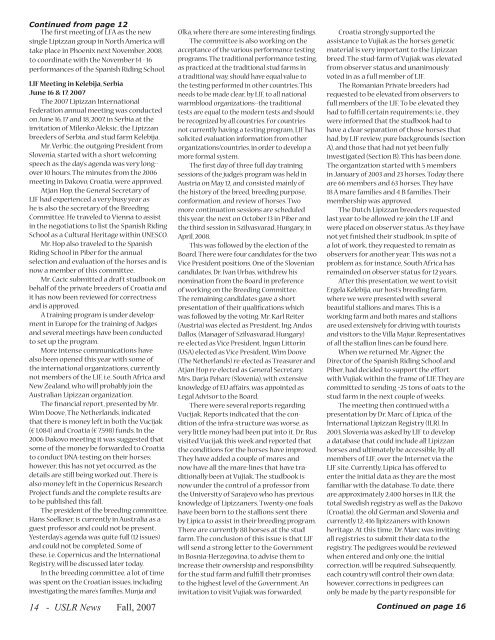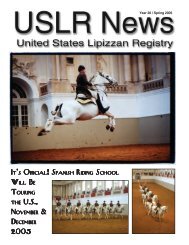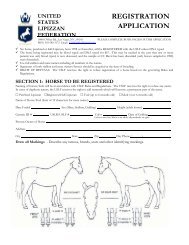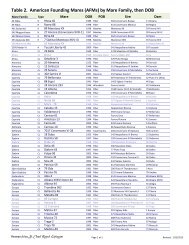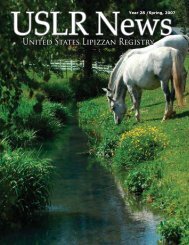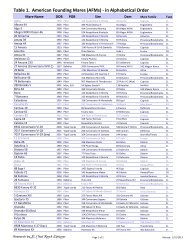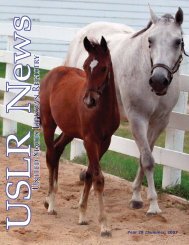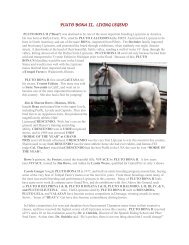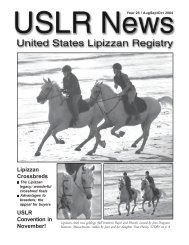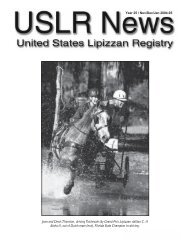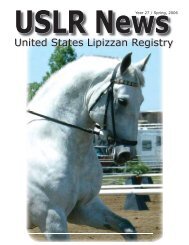Fall 2007 - United States Lipizzan Federation
Fall 2007 - United States Lipizzan Federation
Fall 2007 - United States Lipizzan Federation
Create successful ePaper yourself
Turn your PDF publications into a flip-book with our unique Google optimized e-Paper software.
Continued from page 12<br />
The first meeting of LFA as the new<br />
single <strong>Lipizzan</strong> group in North America will<br />
take place in Phoenix next November, 2008,<br />
to coordinate with the November 14 - 16<br />
performances of the Spanish Riding School.<br />
LIF Meeting in Kelebija, Serbia<br />
June 16 & 17, <strong>2007</strong><br />
The <strong>2007</strong> <strong>Lipizzan</strong> International<br />
<strong>Federation</strong> annual meeting was conducted<br />
on June 16, 17 and 18, <strong>2007</strong>, in Serbia at the<br />
invitation of Milenko Aleksic, the <strong>Lipizzan</strong><br />
breeders of Serbia, and stud farm Kelebija.<br />
Mr. Verbic, the outgoing President from<br />
Slovenia, started with a short welcoming<br />
speech as the day’s agenda was very long--<br />
over 10 hours. The minutes from the 2006<br />
meeting in Dakovo, Croatia, were approved.<br />
Atjan Hop, the General Secretary of<br />
LIF had experienced a very busy year as<br />
he is also the secretary of the Breeding<br />
Committee. He traveled to Vienna to assist<br />
in the negotiations to list the Spanish Riding<br />
School as a Cultural Heritage within UNESCO.<br />
Mr. Hop also traveled to the Spanish<br />
Riding School in Piber for the annual<br />
selection and evaluation of the horses and is<br />
now a member of this committee.<br />
Mr. Cacic submitted a draft studbook on<br />
behalf of the private breeders of Croatia and<br />
it has now been reviewed for correctness<br />
and is approved.<br />
A training program is under development<br />
in Europe for the training of Judges<br />
and several meetings have been conducted<br />
to set up the program.<br />
More intense communications have<br />
also been opened this year with some of<br />
the international organizations, currently<br />
not members of the LIF, i.e. South Africa and<br />
New Zealand, who will probably join the<br />
Australian <strong>Lipizzan</strong> organization.<br />
The financial report, presented by Mr.<br />
Wim Doove, The Netherlands, indicated<br />
that there is money left in both the Vucijak<br />
(€ 1,084) and Croatia (€ 7,598) funds. In the<br />
2006 Dakovo meeting it was suggested that<br />
some of the money be forwarded to Croatia<br />
to conduct DNA-testing on their horses;<br />
however, this has not yet occurred, as the<br />
details are still being worked out. There is<br />
also money left in the Copernicus Research<br />
Project funds and the complete results are<br />
to be published this fall.<br />
The president of the breeding committee,<br />
Hans Soelkner, is currently in Australia as a<br />
guest professor and could not be present.<br />
Yesterday’s agenda was quite full (12 issues)<br />
and could not be completed. Some of<br />
these, i.e. Copernicus and the International<br />
Registry, will be discussed later today.<br />
In the breeding committee, a lot of time<br />
was spent on the Croatian issues, including<br />
investigating the mare’s families, Munja and<br />
14 - USLR News <strong>Fall</strong>, <strong>2007</strong><br />
Olka, where there are some interesting findings.<br />
The committee is also working on the<br />
acceptance of the various performance testing<br />
programs. The traditional performance testing,<br />
as practiced at the traditional stud farms in<br />
a traditional way, should have equal value to<br />
the testing performed in other countries. This<br />
needs to be made clear, by LIF, to all national<br />
warmblood organizations--the traditional<br />
tests are equal to the modern tests and should<br />
be recognized by all countries. For countries<br />
not currently having a testing program, LIF has<br />
solicited evaluation information from other<br />
organizations/countries, in order to develop a<br />
more formal system.<br />
The first day of three full day training<br />
sessions of the judge’s program was held in<br />
Austria on May 12, and consisted mainly of<br />
the history of the breed, breeding purpose,<br />
conformation, and review of horses. Two<br />
more continuation sessions are scheduled<br />
this year, the next on October 13 in Piber and<br />
the third session in Szilvasvarad, Hungary, in<br />
April, 2008.<br />
This was followed by the election of the<br />
Board. There were four candidates for the two<br />
Vice President positions. One of the Slovenian<br />
candidates, Dr. Ivan Urbas, withdrew his<br />
nomination from the Board in preference<br />
of working on the Breeding Committee.<br />
The remaining candidates gave a short<br />
presentation of their qualifications which<br />
was followed by the voting. Mr. Karl Reiter<br />
(Austria) was elected as President, Ing. Andos<br />
Dallos, (Manager of Szilvasvarad, Hungary)<br />
re-elected as Vice President, Ingun Littorin<br />
(USA) elected as Vice President, Wim Doove<br />
(The Netherlands) re-elected as Treasurer and<br />
Atjan Hop re-elected as General Secretary.<br />
Mrs. Darja Peharc (Slovenia), with extensive<br />
knowledge of EU affairs, was appointed as<br />
Legal Advisor to the Board.<br />
There were several reports regarding<br />
Vucijak. Reports indicated that the condition<br />
of the infra-structure was worse, as<br />
very little money had been put into it. Dr. Rus<br />
visited Vucijak this week and reported that<br />
the conditions for the horses have improved.<br />
They have added a couple of mares and<br />
now have all the mare-lines that have traditionally<br />
been at Vujiak. The studbook is<br />
now under the control of a professor from<br />
the University of Sarajevo who has previous<br />
knowledge of <strong>Lipizzan</strong>ers. Twenty-one foals<br />
have been born to the stallions sent there<br />
by Lipica to assist in their breeding program.<br />
There are currently 88 horses at the stud<br />
farm. The conclusion of this issue is that LIF<br />
will send a strong letter to the Government<br />
in Bosnia-Herzegovina, to advise them to<br />
increase their ownership and responsibility<br />
for the stud farm and fulfill their promises<br />
to the highest level of the Government. An<br />
invitation to visit Vujiak was forwarded.<br />
Croatia strongly supported the<br />
assistance to Vujiak as the horse’s genetic<br />
material is very important to the <strong>Lipizzan</strong><br />
breed. The stud-farm of Vujiak was elevated<br />
from observer status and unanimously<br />
voted in as a full member of LIF.<br />
The Romanian Private breeders had<br />
requested to be elevated from observers to<br />
full members of the LIF. To be elevated they<br />
had to fulfill certain requirements; i.e., they<br />
were informed that the studbook had to<br />
have a clear separation of those horses that<br />
had, by LIF review, pure backgrounds (section<br />
A), and those that had not yet been fully<br />
investigated (Section B). This has been done.<br />
The organization started with 5 members<br />
in January of 2003 and 23 horses. Today there<br />
are 66 members and 63 horses. They have<br />
18 A mare families and 4 B families. Their<br />
membership was approved.<br />
The Dutch <strong>Lipizzan</strong> breeders requested<br />
last year to be allowed re-join the LIF and<br />
were placed on observer status. As they have<br />
not yet finished their studbook, in spite of<br />
a lot of work, they requested to remain as<br />
observers for another year. This was not a<br />
problem as, for instance, South Africa has<br />
remainded on observer status for 12 years.<br />
After this presentation, we went to visit<br />
Ergela Kelebija, our host’s breeding farm,<br />
where we were presented with several<br />
beautiful stallions and mares. This is a<br />
working farm and both mares and stallions<br />
are used extensively for driving with tourists<br />
and visitors to the Villa Majur. Representatives<br />
of all the stallion lines can be found here.<br />
When we returned, Mr. Aigner, the<br />
Director of the Spanish Riding School and<br />
Piber, had decided to support the effort<br />
with Vujiak within the frame of LIF. They are<br />
committed to sending ~25 tons of oats to the<br />
stud farm in the next couple of weeks.<br />
The meeting then continued with a<br />
presentation by Dr. Marc of Lipica, of the<br />
International <strong>Lipizzan</strong> Registry (ILR). In<br />
2003, Slovenia was asked by LIF to develop<br />
a database that could include all <strong>Lipizzan</strong><br />
horses and ultimately be accessible, by all<br />
members of LIF, over the Internet via the<br />
LIF site. Currently, Lipica has offered to<br />
enter the initial data as they are the most<br />
familiar with the database. To date, there<br />
are approximately 2,400 horses in ILR, the<br />
total Swedish registry as well as the Dakovo<br />
(Croatia), the old German and Slovenia and<br />
currently 12, 416 lipizzaners with known<br />
heritage. At this time, Dr. Marc was inviting<br />
all registries to submit their data to the<br />
registry. The pedigrees would be reviewed<br />
when entered and only one, the initial<br />
correction, will be required. Subsequently,<br />
each country will control their own data;<br />
however, corrections in pedigrees can<br />
only be made by the party responsible for<br />
Continued on page 16


